Hummingbirds, those tiny, beautiful birds that can fly up to about 60 miles per hour, are a joy to watch. They love the color red and will often hover in front of it before darting off to find nectar. Hummingbird feeders are a great addition to any garden because they help these lovely creatures thrive while also providing entertainment for humans!
But flowers are better! Here are 12 beautiful perennial flowers that attract hummingbirds. Adding these to your garden will provide food and shelter for the hummers.
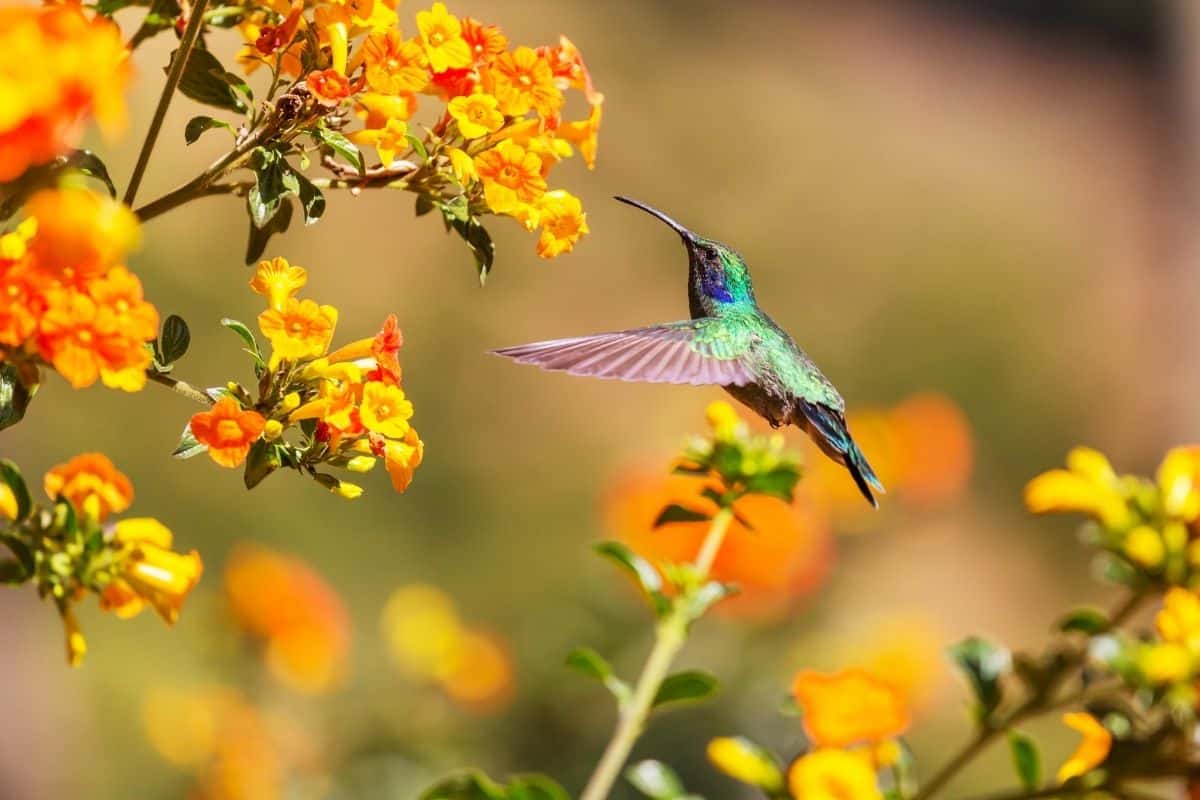
Many people love the unique and beautiful garden visitor known as the hummingbird. The ruby-throated hummingbird is by far the most well-known and famous in North America, but there are many stunning examples of these tiny birds. They are a joy to watch and are a vital part of the natural cycle of pollination and plant reproduction. That and their stunning appearance and beauty also means many people enjoy having them around.
From hanging feeders to designing gardens specifically for these flying jewels, it is clear people will go to great lengths to attract these birds to their yards. The best way to do this is to embrace a diverse collection of attractors, especially when it comes to the flowers chosen.
A diverse hummingbird garden will help bring in more birds as well as appeal to more species to keep the population rotating out with the migratory patterns of various hummingbirds. If your home is within migratory flight paths, ensure there are flowers for hummingbirds to feed on throughout the year and entice them to stop over during their migration.
But what are the best hummingbird flowers and plants to use in the first place, and how can you best design a garden that is safe and accessible for hummingbirds? Read on to find out the best perennial flowers that attract hummingbirds and that will make your garden a haven for hummingbirds.
12 Perennial Flowers That Attract Hummingbirds to the Garden
1. Butterfly bush (Buddleia davidii)
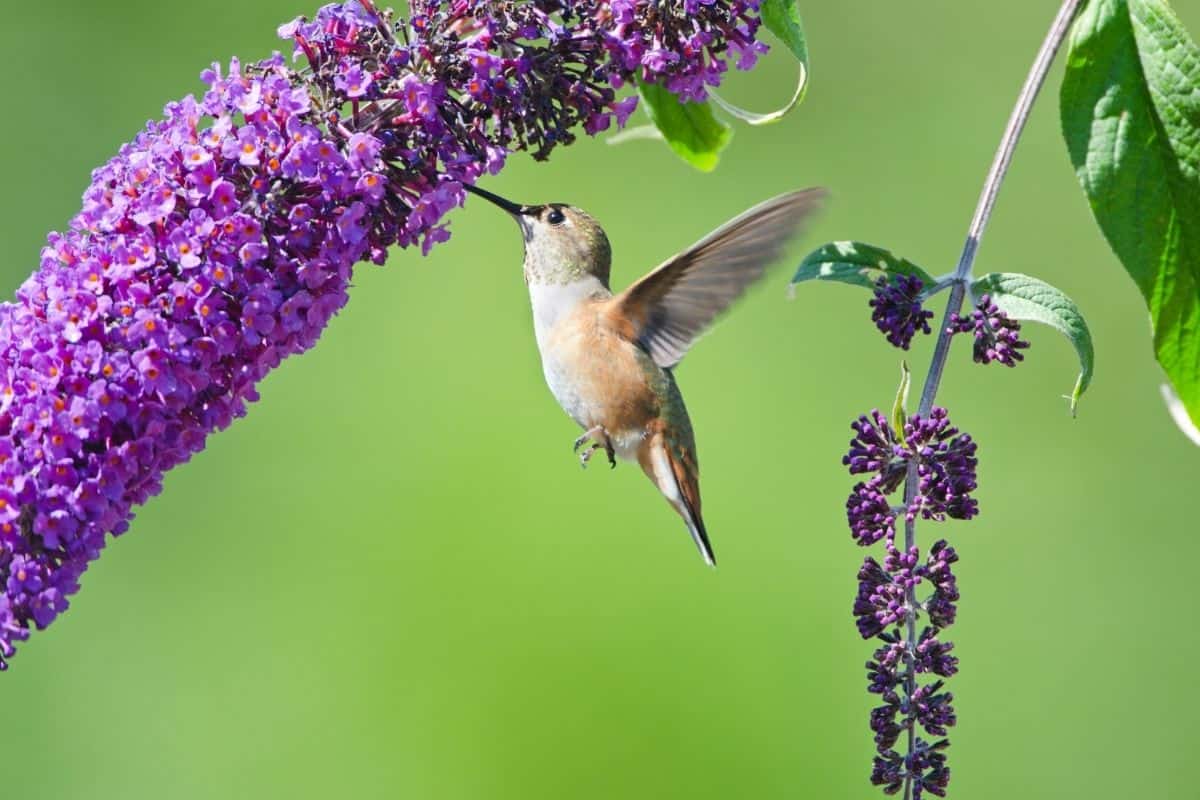
While obviously a popular food source for butterflies, this plant is also perfect for hummingbirds as well. The thick, elongated plumes of small tubular flowers offer several cycles of blooms for an extended season that keeps the garden looking bright and keeps the hummingbirds coming back.
The butterfly bush is an extremely drought-tolerant plant that requires little to no care once it is established. It has a large bush-like growth pattern and can reach a height and spread over more than 4 feet over time. It is great as a focal plant or a standalone planting in the garden.
Caution: This plant is deemed by some states as an invasive species so be sure to check local regulations before planting it in your gardens or landscapes.
- USDA Growing Zones: 5 to 10
- Color Varieties: Shades of red, pink, purple, white, and blue
- Sun Exposure: Full direct sun with little to no shade
- Soil Needs: Well-drained soil with periods of soaking between drying out.
2. Coral honeysuckle (Lonicera sempervirens)
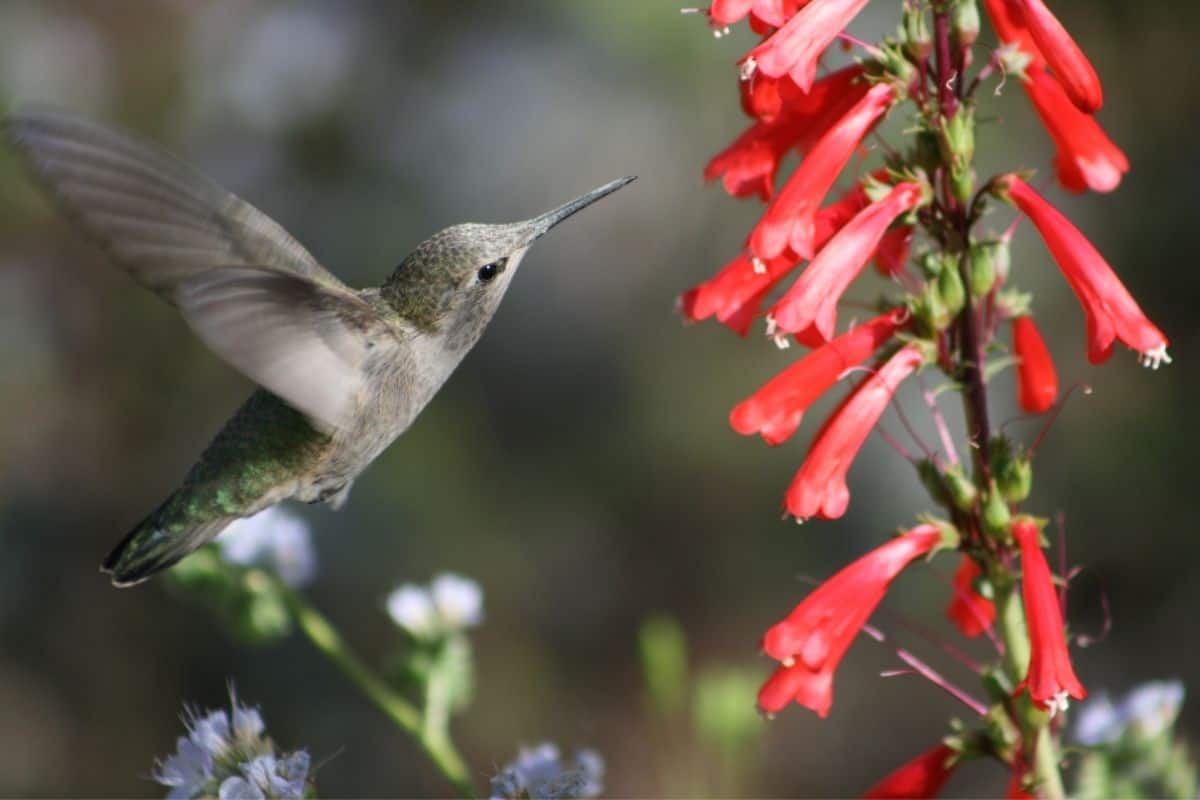
This is a species of the common honeysuckle vine, which itself is a popular native flower in the eastern United States. Common honeysuckle is usually a cream to yellow color, but the coral honeysuckle is prized among gardeners for its stunning red flowers.
As a vining plant, the honeysuckle needs to be planted in an area where it can easily climb and spread. Along a fence, against a trellis, or climbing a gazebo are stunning ways to display this unique flowering perennial. Hummingbirds, butterflies, and bees alike will flock to its trumpet-shaped flowers for as long as they are in bloom.
- USDA Growing Zones: 5 to 9
- Color Varieties: Red to orange
- Sun Exposure: Bright sun to light shade
- Soil Needs: Rich soil that drains well
3. Bee balm (Monarda didyma)
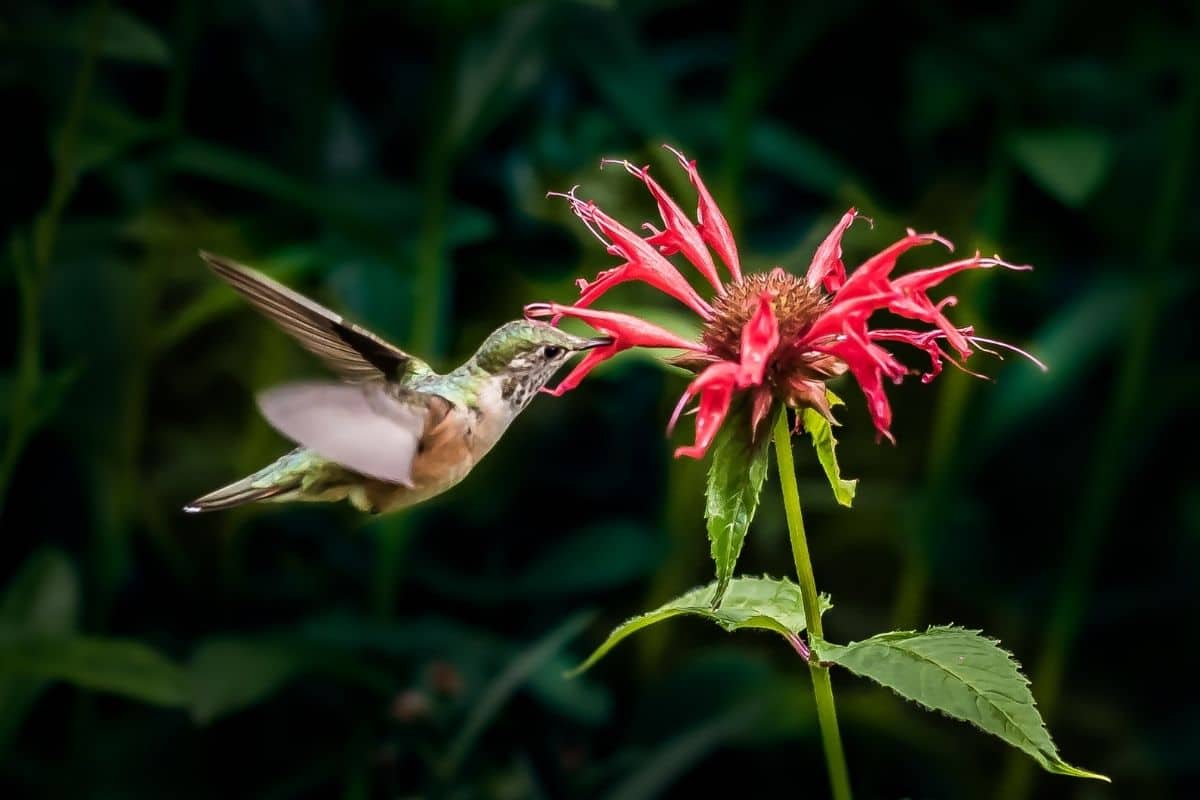
The large and brilliant spikes along with the spherical shape of these popular garden plants have made them a staple in landscapes across the country. For those interested in attracting hummingbirds, the bee balm makes an interesting and attractive plant to add to any landscape plan. These stunning plants are a well-known attractor for not just hummingbirds but also butterflies, bees, and other essential pollinators.
This flower has a normal growth of around two to four feet in height and requires dividing every so often to keep it healthy and to avoid it getting root bound. If the flowers are allowed to go to seed, the bee balm will self-seed itself with additional plants the following year as well as regrowing from the established root system.
- USDA Growing Zones: 4 to 9
- Color Varieties: Red is the most common but shades of purple and orange can also be easily found
- Sun Exposure: A full range from sun to shade
- Soil Needs: Rich with organic matter that drains well
4. Salvia (Salvia spp.)
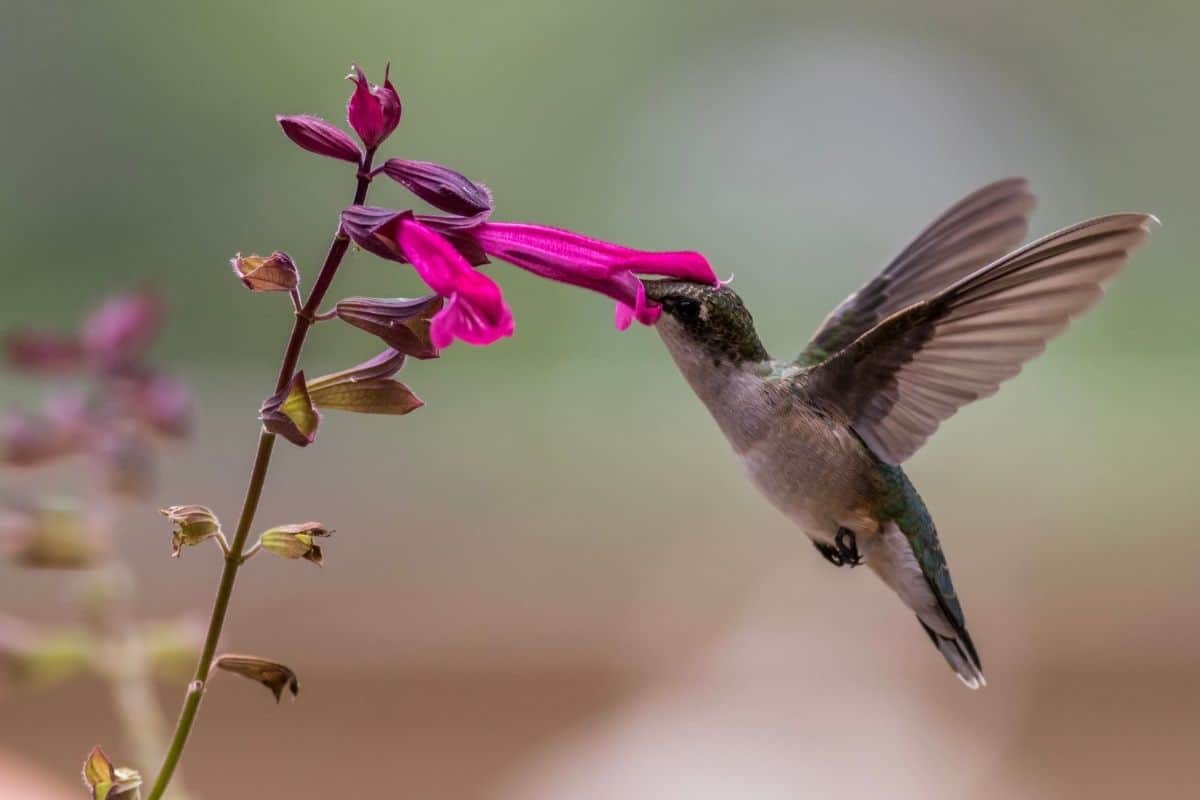
This plant family is actually a member of the mint family and is quite large. Many different varieties have been developed – both annual and perennial – and almost all of them are great choices for a hummingbird garden. Tall spikes of small, delicate flowers have made it a common garden plant for quite some time.
Perennial salvia flowers offer a range of colors that can help attract hummingbirds to their nectar-filled flowers. The unique shape of some salvia flowers is made for hummingbird’s long narrow beaks which makes them an even better choice for the garden. Reaching 18-36 inches in height and spread this is a very easy plant to grow and care for.
- USDA Growing Zones: 4 to 11
- Color Varieties: Purple, red, pink, blue, orange, and many more
- Sun Exposure: Full direct sun
- Soil Needs: Dry to slightly moist conditions with well-drained soil
5. Cardinal flower (Lobelia cardinalis)
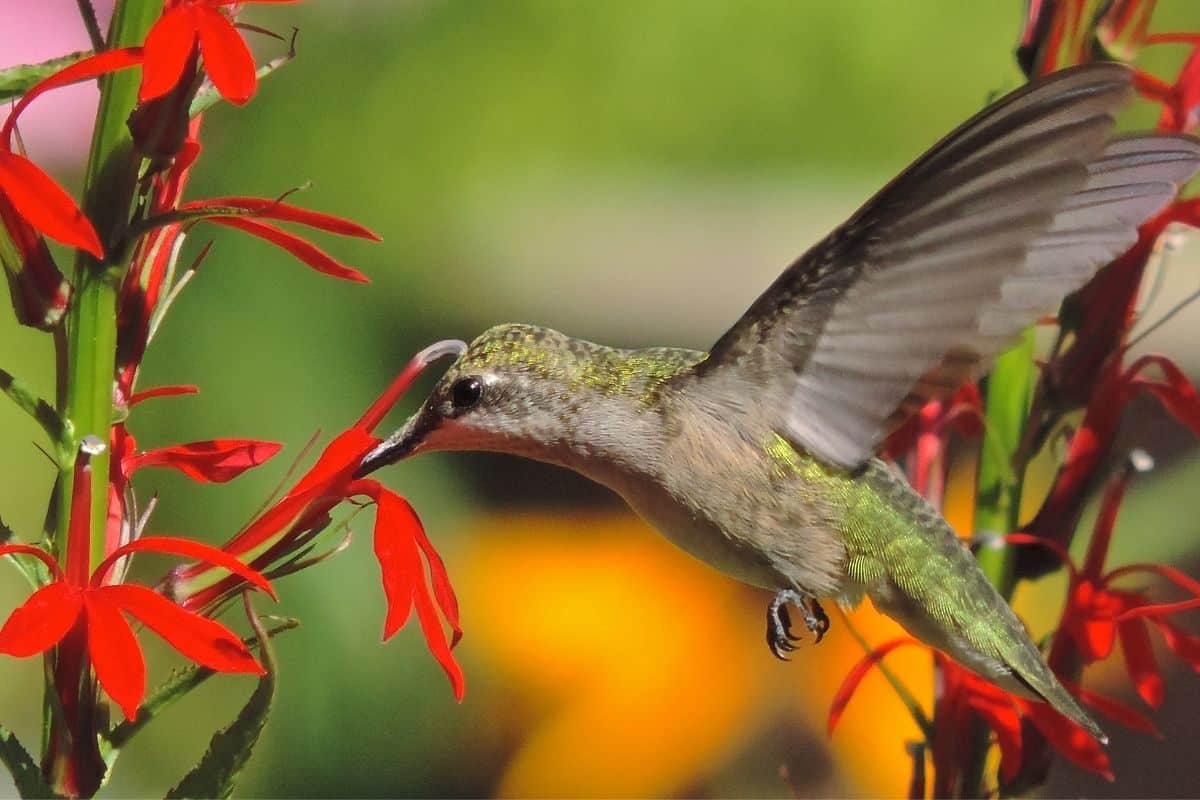
Another popular flowering perennial, the cardinal flower produces long stalks of flowers that form brilliant spikes. These stunning displays of blooms can reach as high as four feet. Its rich blossoms are delicately shaped, which adds an air of elegance and beauty to the garden while also attracting hummingbirds to its flowers.
It is best used at the back of garden beds and along fences and walls due to its towering size potential. It is a voracious seeder and will maintain a presence in the garden so long as the blooms are allowed to go to seed.
- USDA Growing Zones: 3 to 9
- Color Varieties: Scarlet red is by far the most common but white and pink varieties can be found in some areas
- Sun Exposure: Part sun to full sun
- Soil Needs: Organically rich soil that stays moist
6. Bleeding heart (Lamprocapnos spectabilis)
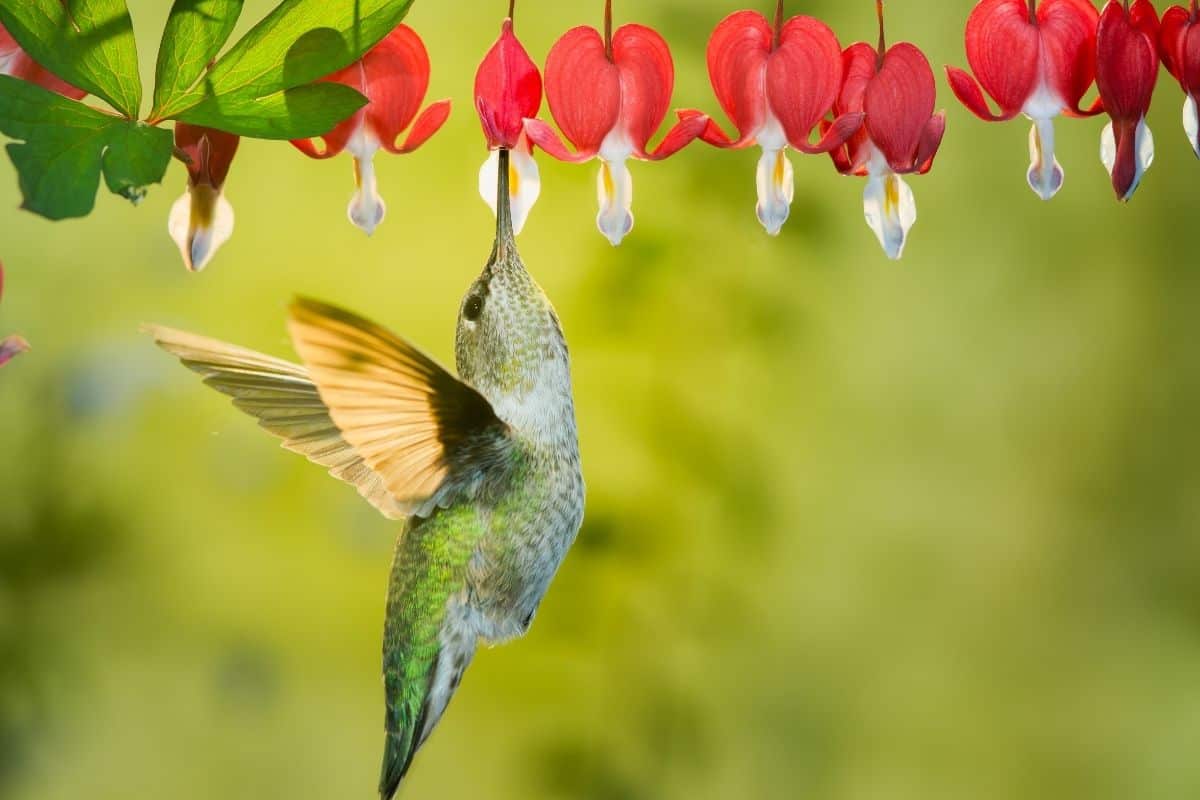
A spectacular perennial plant with beautiful greenery and hanging, heart-shaped blooms are a very well-known sight among gardeners. The bleeding heart performs best in cooler climates where it can reach mature sizes of around 24 to 36 inches tall. They can easily be divided and propagated with cuttings to produce even more stunning plants. Learn more about growing bleeding heart flowers.
Foliage can die back when the summer heat gets too intense, but the plants reliably grow back each season with the cooler weather. It is susceptible to root rot and does best where it can hang and trail or staked to a trellis or fence or other support.
- USDA Growing Zones: 2 to 9
- Color Varieties: Shades of red, pink, and white
- Sun Exposure: Partial to full shade
- Soil Needs: Rich well-drained soil that doesn’t dry out
7. Trumpet creeper (Campsis radicans)
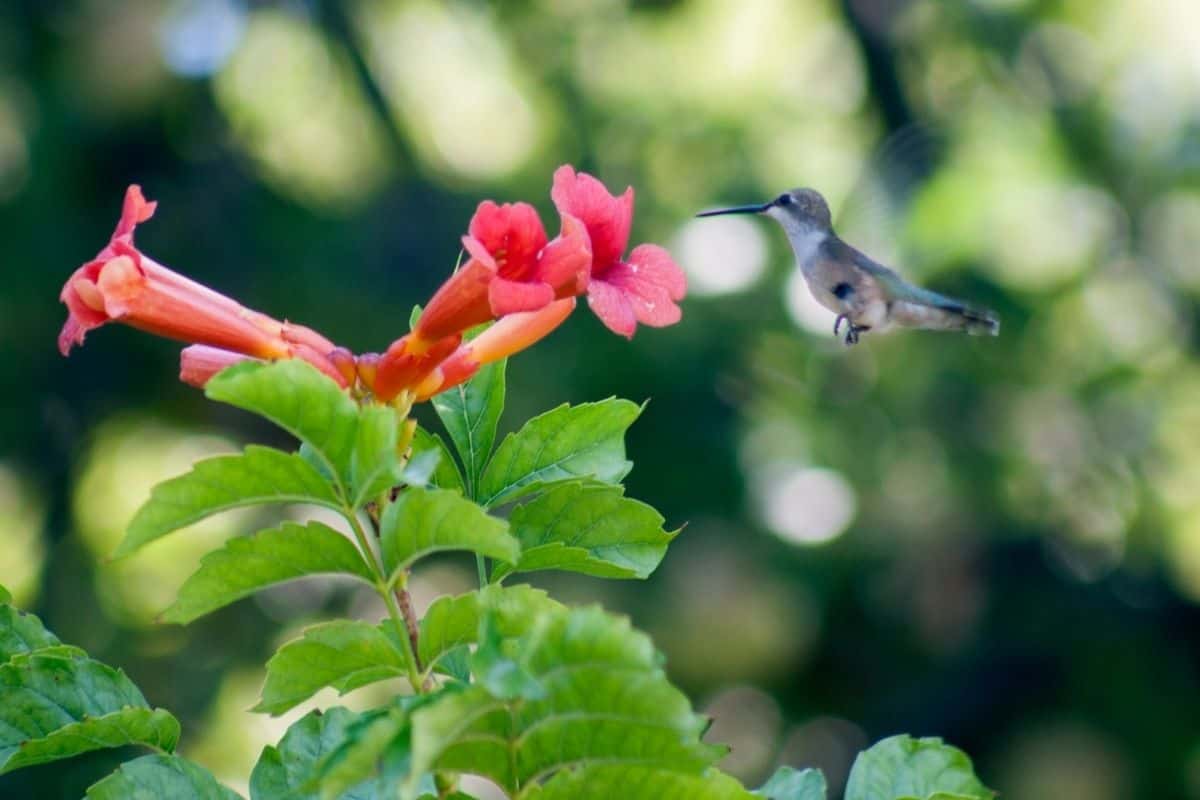
Also known among gardeners as the trumpet vine or the aptly named hummingbird vine, this is a fast-growing plant that can dominate the garden. It can quickly take over a space with a trailing and vining growth habit that will climb anything and everything it can attach itself to. It has dense foliage and its long, tubular flowers are made for hummingbirds.
It thrives in many gardens and is commonly grown in containers and baskets to help control its rapid spread. Regular pruning is needed to keep it from taking over the garden in some cases. But its brilliant flowers and glossy foliage make it a popular plant still for many gardeners across the country.
- USDA Growing Zones: 4 to 10
- Color Varieties: Orange, red, yellow
- Sun Exposure: Partial to full shade or morning sun
- Soil Needs: Average soil, well-drained and rich in organic matter
8. Lupine (Lupinus x hybridus)
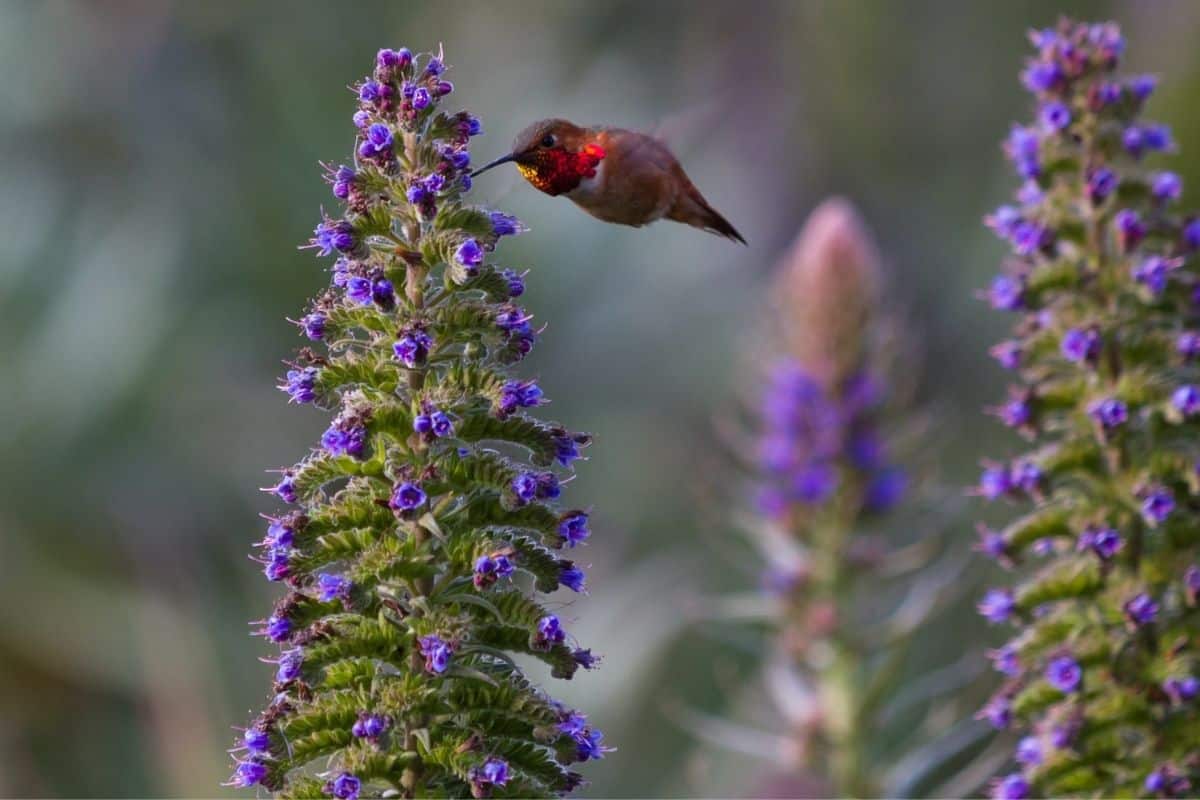
Wild lupines are not made for home gardens but thankfully there are many hybrids that can become excellent specimens of garden perennials. This early-blooming flower help provide hummingbirds with food supplies before the flowers even appear as some common insects that hummingbirds eat tend to be found on lupine plants.
Plants characteristically reach three to four feet tall with dense spikes of flowers, although there are also dwarf varieties that max out under two feet tall. No division is necessary, but they tend to die out in most regions after 3 years or so and need to be replaced. In hotter climates, lupines primarily are treated as annuals.
- USDA Growing Zones: 4 to 8
- Color Varieties: Purple and blue are most common though white and pink varieties have been developed
- Sun Exposure: Full direct sun
- Soil Needs: Moist slightly acidic soil that is well-drained
9. Columbine (Aquilegia spp.)
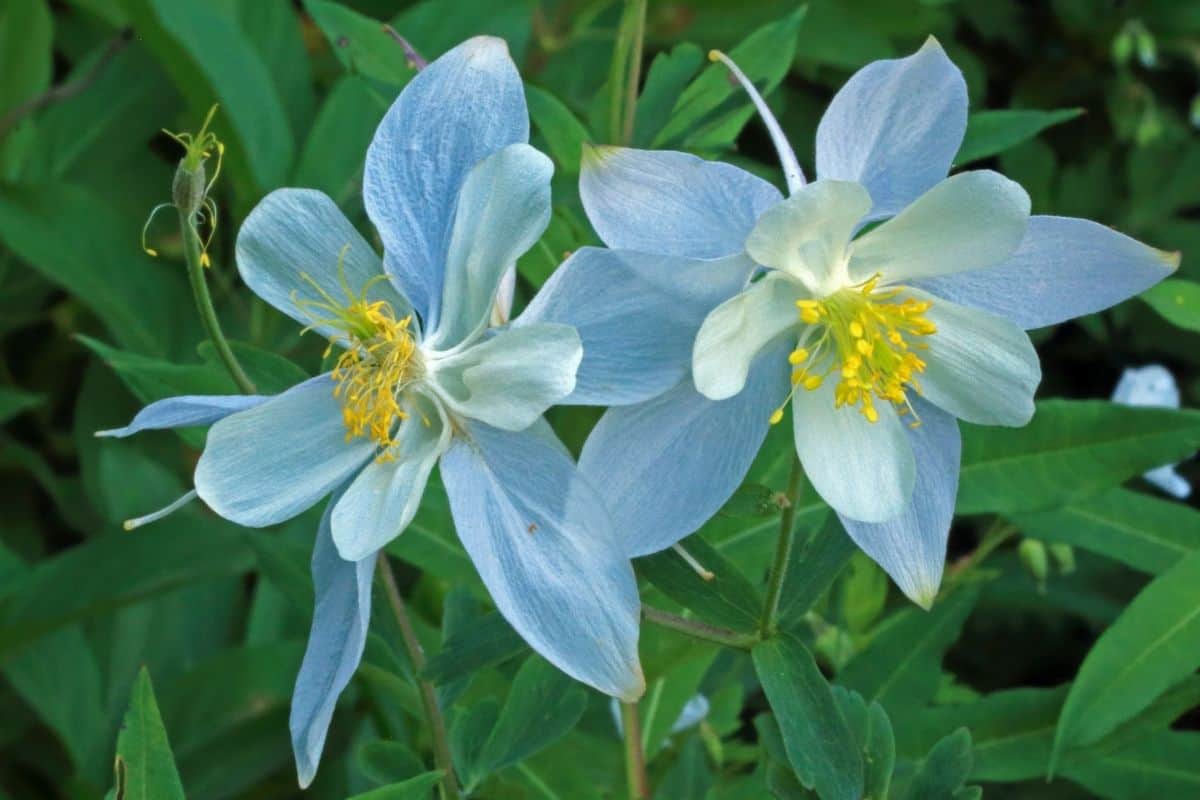
There are several species of columbine commonly grown as a garden perennial. But even more cultivars and hybrids have been developed specifically for their color, bloom duration, and hardiness. This makes the columbine a great choice of an addition to a hummingbird garden.
Columbine is usually seen planted around fences, trees, and flower beds. It grows from one to three feet high, with a good bit of variation in height and spread depending upon the variety planted. The flowers are simple and colorful and are popular with a wide range of pollinators, including hummingbirds.
- USDA Growing Zones: 3 to 8
- Color Varieties: Blue, lavender, purple, coral, pink, and white
- Sun Exposure: Part shade to full sun
- Soil Needs: Medium-rich soil that is light and well-drained
10. Petunia (Petunia Group)
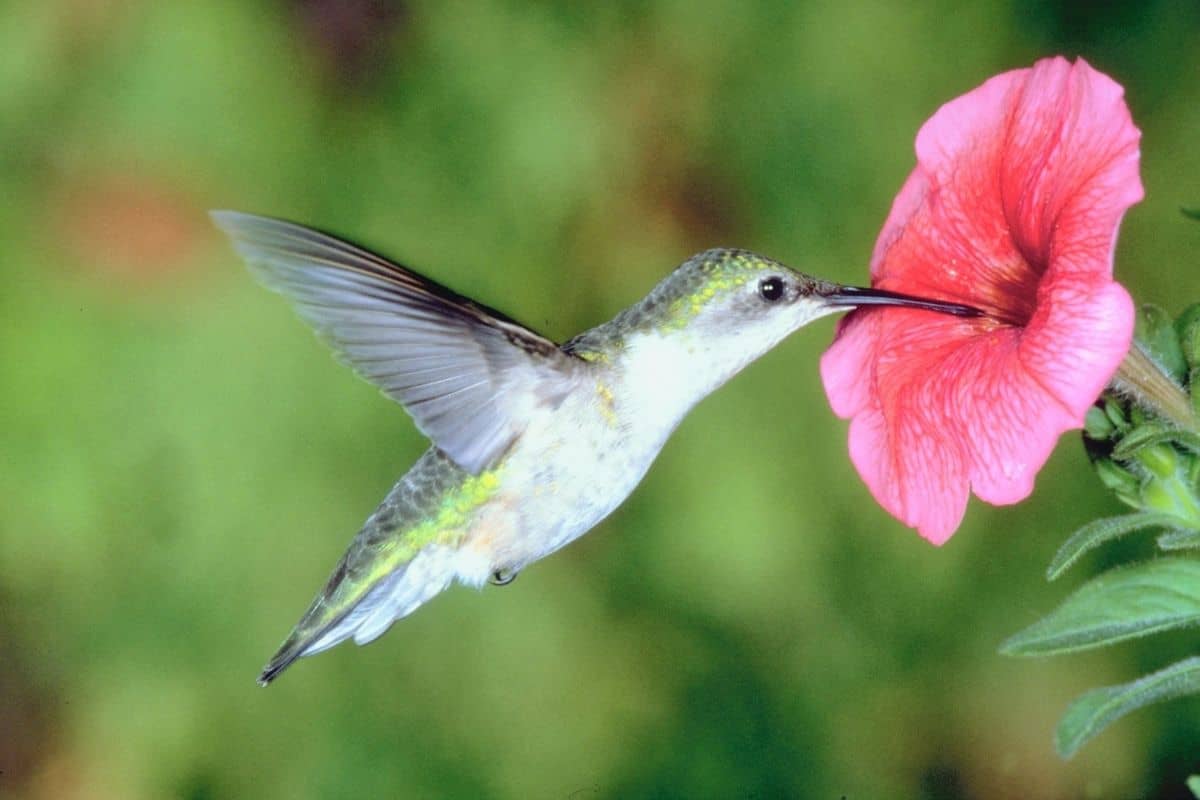
Petunias are often considered an annual plants but they can be grown as a perennial at times when kept in containers or baskets or protected from freezes in the garden. They work well with just about any other plant and come in an array of colors that make them a popular choice for flower beds and baskets.
The petunia plant will bloom repeatedly, which offers hungry hummingbirds a long-lasting supply of nectar. The bright colors attract the birds and are a great addition to a hummingbird garden as their compact growth allows them to easily be added in mounding clumps and patches.
- USDA Growing Zones: 10 to 11
- Color Varieties: Pink, blue, white, orange, red, purple, mixed colors
- Sun Exposure: Direct sun
- Soil Needs: Medium-rich soil that is moist but well-drained
11. Hummingbird mint (Agastache, spp.)
Also commonly known as Hummingbird Mint, or Hyssop, this plant is a perfect choice for any hummingbird garden. A member of the mint family, these plants produce bright clusters of flowers that are showy, fragrant, and long-blooming perennials.
They are aptly named as they are a primary attractor to hummingbirds as well as butterflies. As an added bonus, these plants have excellent resistance to temperatures and harsh soil and weather conditions. They also hold up well against browsing deer and rabbits.
- USDA Growing Zones: 4 to 7
- Color Varieties: Pink, red, and white mostly
- Sun Exposure: Direct sun to some shade
- Soil Needs: Medium-rich soil with periods of moisture then drying out
12. Coral bells (Heuchera spp.)
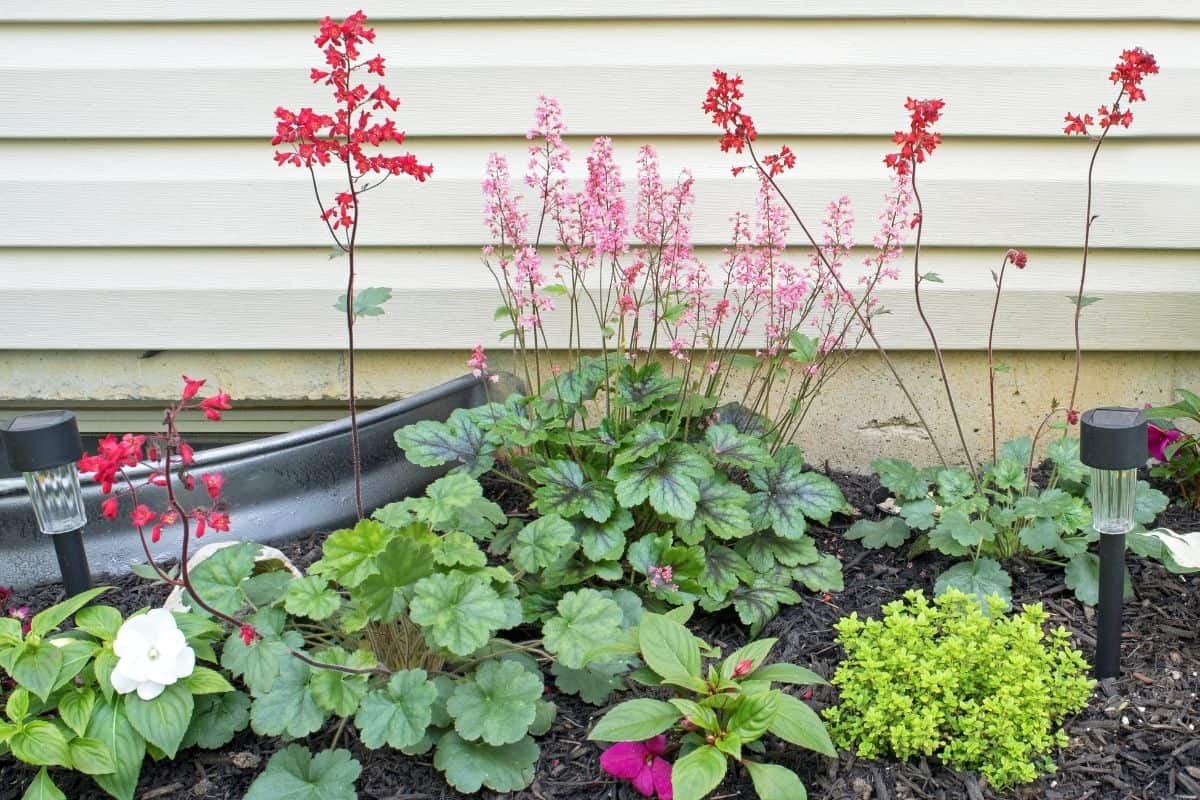
While standard green is the most common foliage for this stunning plant it can also be seen with bronze, purple, red, and other vibrant colors. The spikes of tall, bell-shaped blooms, its obvious namesake, come out in full force in late spring to early summer. There are also late-blooming types available.
The flower color can be varied too and mixes well with the various foliage shades to create a stunning focal point in any garden. Bell-shaped flowers of various colors and tones are wonderful attractors for hummingbirds, bees, and butterflies alike.
USDA Growing Zones: 3 to 10
- Color Varieties: Pink, red, purple, coral, and white
- Sun Exposure: Shade to filtered partial sun
- Soil Needs: Average soil that holds moisture but is well-drained
FAQ on how to attract hummingbirds
Here are a few handy tips to maximize your yard’s appeal and create the perfect habitat for these tiny winged beauties.
Do hummingbirds like spiderwebs?
To more easily attract hummingbirds to your garden, be a friend to the spiders, and don’t remove the webs that appear in and around the garden area. Hummingbirds use the sticky webs as nesting materials. And hummingbirds often steal insects out of spider webs to eat. So, keeping spiders around can help make your garden more appealing and habitable for hummingbirds, even if you are limited to small spaces.
How many species of hummingbirds can I find?
There are an estimated 300 hummingbird species worldwide and some new ones are discovered every few years. Out of these hundreds of varieties, fewer than two dozen can be seen as far north as the United States and Canada. Out of these, only a handful are year-round residents of North America. Knowing what species are in your area can help you plan the best planting schedule for those hummingbirds.
To learn more about hummingbirds, you might want to buy a field guide specific to hummingbirds.
What does it mean to have a continuous blooming schedule?
As you work on planning what plants to include in your hummingbird garden, make sure to select plants that have varying blooming periods. Continuous blooming means there are always flowers in the garden and any hummingbirds passing through will always have a reason to hang out in your garden. This is especially true in the fall months when it can be harder for the birds to find food.
Why is a mister recommended for a hummingbird garden?
A mister is a simple attachment that fits a regular garden hose that creates a fine mist when turned on. Hummingbirds, like all birds, will take a dip in the water of a birdbath, but a mister is nearly irresistible. Hummingbirds will often flit through the mist to clean themselves and then find a place to roost to preen and dry off. Misters are easy to find and use and are not major water users either so it is a win-win (this one is a favorite).
Should a hummingbird feeder be included in the garden space?
To ensure hummingbirds visit your yard and hang out for as long as possible proper maintenance and upkeep on your feeders is a must. Make sure you are using a safe formulation in your feeder (make your own hummingbird food) and that they are cleaned and changed out regularly. And once the hummingbirds arrive be sure to keep it filled because they will come to rely on that food source during their stay.
Are there other plantings that can complement a hummingbird garden?
Even if hummingbirds are not directly attracted to a certain plant, they can still help make the garden more attractive for the birds. Herb gardens provide a food source for bugs, trees offer places for roosts and nests, and many other native plants can also help provide food and shelter for hummingbirds and other birds too. Diversity is the goal both for your own enjoyment and for the wildlife as well.
Now that you know the best perennial flowers that attract hummingbirds and what you can do to make your yard into a hummingbird garden and safe haven, it is time to take action. Take what you have learned and put it into practice and enjoy regular visits from these stunningly beautiful birds!
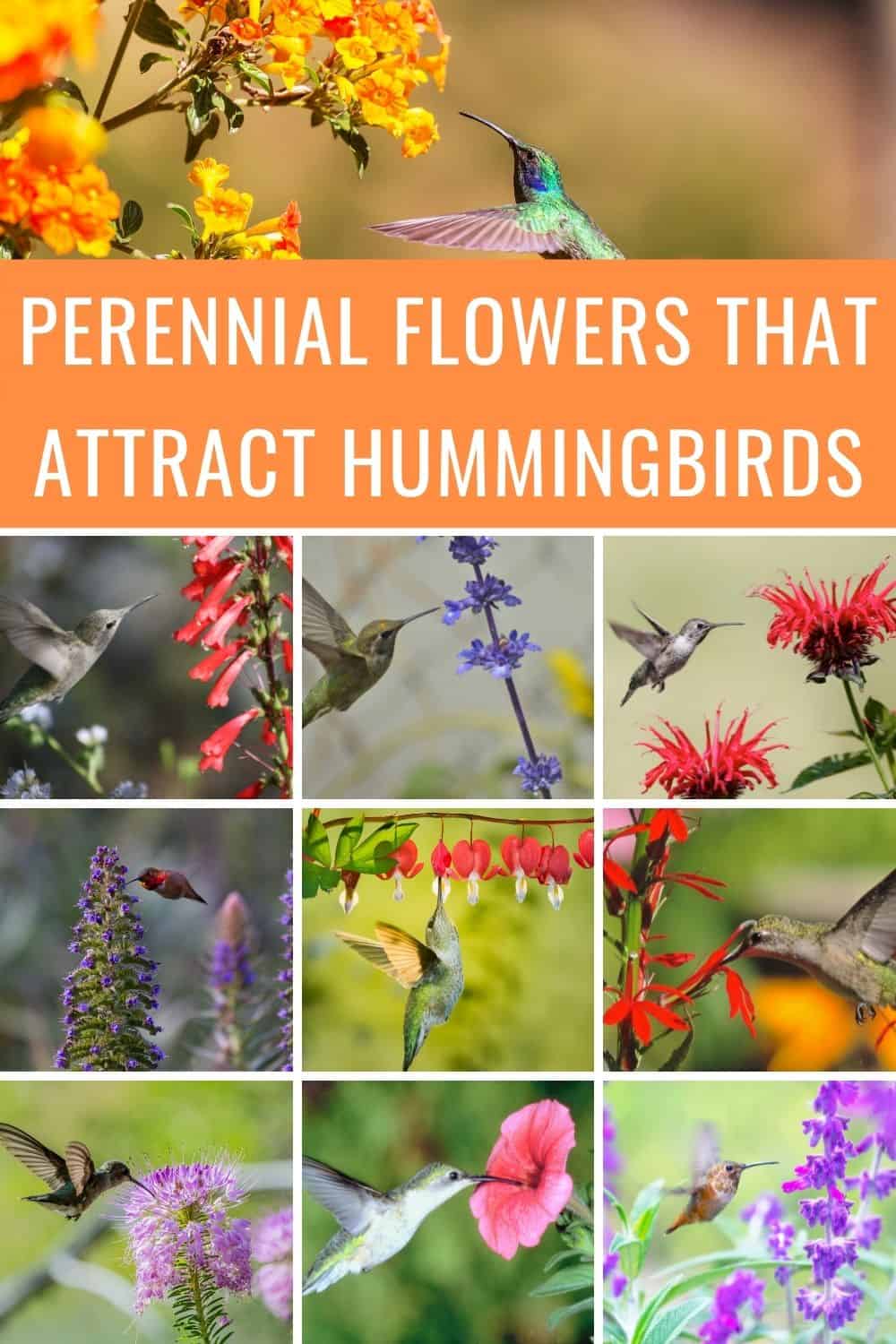

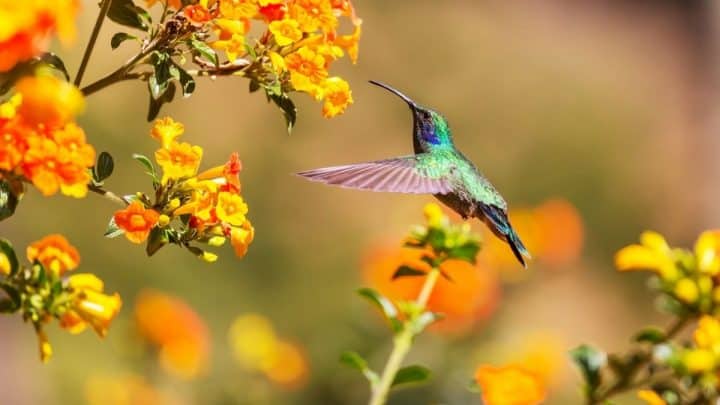


Georgia Native Plants List: 13 Southern Beauties For Your Landscape
Tuesday 14th of February 2023
[…] looks pretty, smells great, and is a big favorite of hummingbirds and bees. It’s great as a climber and also as ground cover and it’s not especially […]
The 11 Best Large Indoor Plants For Your Home
Monday 6th of February 2023
[…] The yucca is a tall, evergreen perennial with thick, broad leaves that fan out from the central stem. It has small white flowers that bloom in summertime that are fragrant and attract hummingbirds. […]
How To Grow Snapdragons - An Easy Guide [Lots Of Pictures]
Monday 21st of November 2022
[…] will attract hummingbirds and butterflies to your […]
11 Best Companion Plants For Hydrangeas
Monday 20th of June 2022
[…] gold, lime-green, purple, red, and rose. They put out tiny bell-shaped flowers rich in nectar that attract hummingbirds and butterflies in droves. Their leaves provide an interesting contrast to the flowers of either […]
What Do Hummingbirds Eat? A Quick And Easy Guide To Feeding Hummers
Tuesday 10th of May 2022
[…] perennial flowers that attract hummingbirds […]